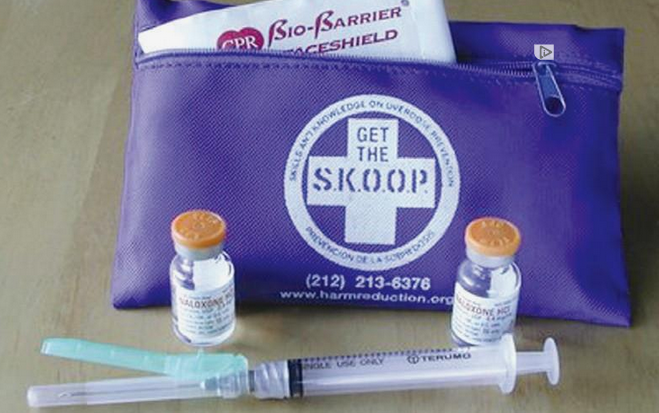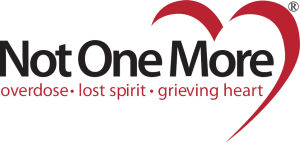
Effort hopes to put heroin antidote in hands of public
By Sylvie Belmond
belmond@theacorn.com
View Full Story
LIFELINE— This overdose prevention kit comes from S. K. O. O. P. ( Skills and Knowledge on Overdose Prevent ion). The injectable life-saving drug is Naloxone. No one wants to imagine a loved one overdosing on heroin or painkillers.
But in the event such an emergency occurs, an antidote is available that can prevent the overdose from turning deadly.
About 20 people attended an overdose prevention and response training class in Oak Park last week where they were taught how to use an injectable medicine that reverses the deadly effects of opiate overdose.
Also known as the “secondchance drug,” naloxone hydrochloride neutralizes the effects of opioids, allowing drug users to breathe during an overdose. The prescription medication has been used in ambulances and hospitals for decades to reverse opioid overdose.
“Deaths from drug overdose have hit the local area hard in recent years,” said Loretta Di Lustro, whose son, John, died from respiratory failure after an accidental heroin overdose in 2011.
DOSE OF PREVENTION—Adam Butler, left, from L.A. Community Health Outreach Project, explains to Dane Kigerl how to use naloxone, an injectable medicine that reverses deadly effects of opiate overdose. SYLVIE BELMOND/Acorn Newspapers The Oak Park resident hosted the recent training class at her home. She and other parents affected by opioids hope to work with lawmakers and healthcare providers to expand access to the lifesaving prescription drug, which is sold under the brand name Narcan.
“Our goal is to have naloxone in our homes, just like epinephrine and syrup of ipecac that people keep at homes. I do not want to have another mother plan her child’s funeral. I don’t want another father to cry in silence. . . . It’s about getting the word out to save kids,” Di Lustro said.
Adam Butler, a consultant with L.A. Community Health Outreach Project who helped develop a statewide overdose prevention and naloxone distribution network in Massachusetts, said the antidote is safe for nearly everyone and people can’t get high from it.
An overdose occurs when too much of an opioid strikes too many brain receptors, slowing and then stopping the victim’s breathing. Overdoses are rarely instantaneous and usually happen one to three hours after the drug was used. Naloxone kicks the opioid off the receptors, providing a 30 to 90 minute window to save someone’s life.
Bystanders should call 911 and perform rescue breathing until paramedics arrive.
Because naloxone also causes instant withdrawal symptoms, it should not be used to discipline an addict, as that could put the user at risk of taking another dose of opioids.
“This is not a punishment drug. This is a lifesaving drug,” Butler said.
Opioids come in the form of heroin powder and a variety of prescription drugs such as oxycodone, Vicodin and Demerol. Naloxone has no effect on other types of drugs.
Butler demonstrated how naloxone is injected into the arm or leg muscle, and each participant received a kit containing three naloxone doses and syringes.
Pat Montoya, a member of Simi Valley’s Task Force on Heroin Prevention and chair of Not One More, a grassroots organization fighting drug abuse and overdose in Simi Valley, said naloxone is a vital tool in the fight to prevent opiate-related deaths.
“I think this program needs to get out to the general public. . . . If one life is saved with the reversal kits then it will be a success,” Montoya said.
In January 2013, Assembly Bill 472 went into effect. Also known as the California 911 Good Samaritan Law, it provides limited protection from arrest and prosecution for people who seek emergency medical assistance at the scene of a suspected drug overdose. The law was passed to encourage quick medical care for an overdose victim, regardless of how culpable the person who is making the 911 call might be.
As of January 2014, Assembly Bill 635, the Overdose Treatment Act, is intended to encourage healthcare providers and community programs in California to distribute the overdose antidote.
With the take-home naloxone program, many fatal opioid overdoses could be prevented, Di Lustro said.
“ We want our kids sober, but the reality is we need them alive,” said Di Lustro, who is involved with local support groups that work to support, educate and help families affected by drug use.
Susan Klimusko, founder of the Not One More organization, also strives to change perceptions and save lives.
“We, as moms, are coming together across the country. My hope is to work with the city and police department, and to become a trainer in my community to expand access to Narcan in Simi Valley,” Klimusko said.
Agoura Hills resident Lauren Isaac, whose brother, Josh, died of a heroin overdose in August, said it’s important to reach young people so they know what to do if a drug-related emergency happens.
“It was painful for me to learn about heroin overdose and to really understand the details of my brother’s death, but I pushed through the pain because I hope that someday I will be able to save the life of someone else’s sibling so that they do not experience what I am going through,” Isaac said.
Three women from Orange County, as well as Acton resident Natalie Kigerl and her son Dane, came to the Oak Park presentation to take advantage of the training and obtain an antidote kit.
“I have friends that do it (take drugs),” Dane said. “So I will be able to have the insight and knowledge on how to prevent an overdose.”
To learn more about naloxone distribution efforts, visit www.lachop.org.
